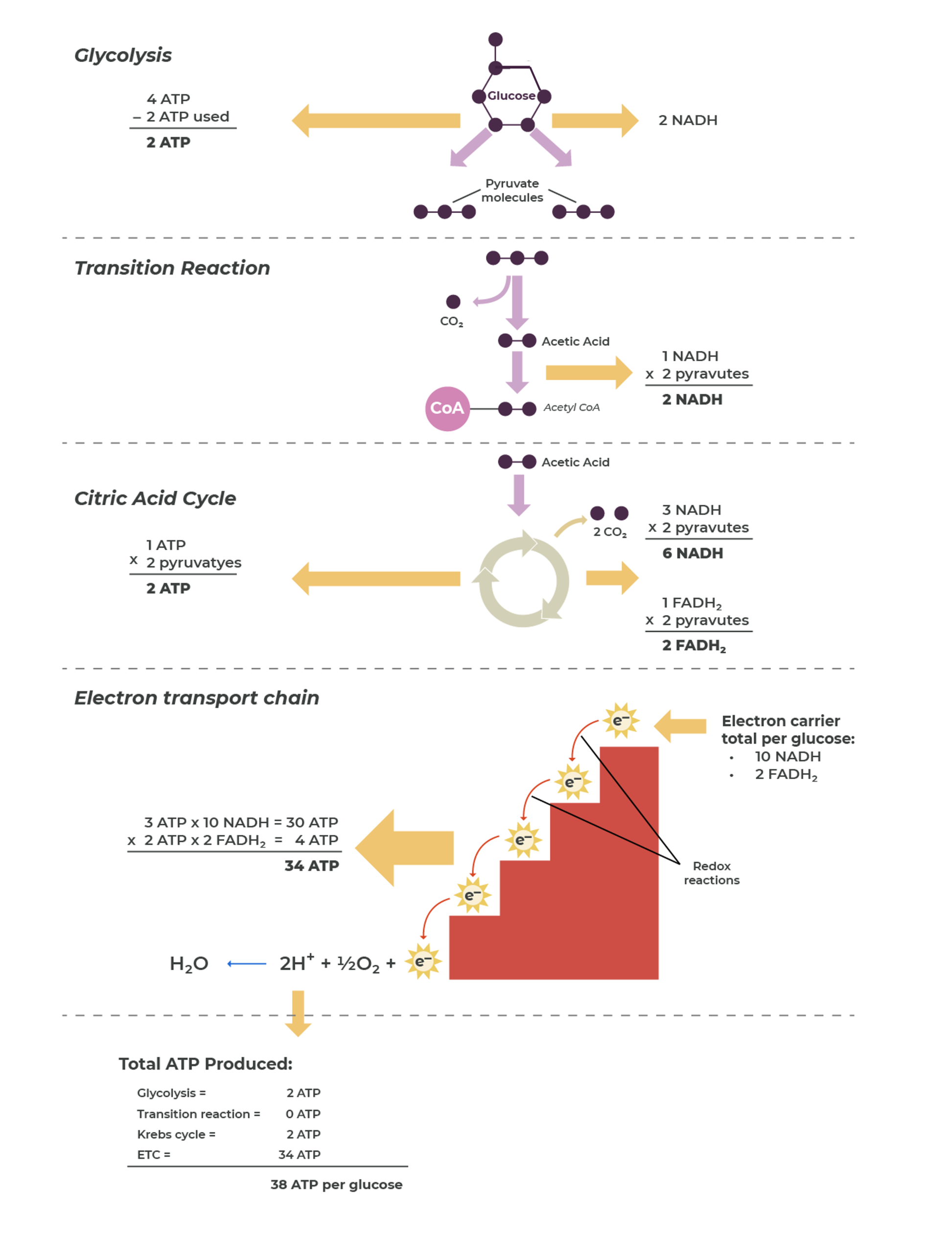6.1 Overview of Cellular Respiration
Cellular respiration is the process by which living cells break down glucose molecules and release energy.
Redox Reactions
Most of the energy stored in molecules is in the form of high-energy electrons. The shift of an electron from one molecule to another removes some potential energy from the first molecule and increases the potential energy of the second molecule. In cellular respiration, the high-energy electrons from glucose are passed through a series of redox reactions, ultimately leading to the production of ATP. Redox (reduction-oxidation) reactions are chemical processes involving the transfer of electrons between two substances. An oxidation reaction strips an electron from a molecule, and the addition of this electron to another molecule is a reduction reaction. The transfer of energy in the form of electrons allows the cell to transfer and use energy in an incremental fashion—in small packages rather than in a single, destructive burst.
Stages of Cellular Respiration
Cellular respiration involves many chemical reactions, but they can all be summed up with this chemical equation:
C6H12O6 + 6O2 → 6CO2 + 6H2O + Chemical Energy (in ATP)
In other words, the equation shows that glucose (C6H12O6) and oxygen (O2) react to form carbon dioxide (CO2) and water (H2O), releasing energy in the process. Because oxygen is required for cellular respiration, it is an aerobic process. This is the reason why we breathe oxygen in from the air. This type of respiration releases a large amount of energy from glucose that can be stored as ATP. Most animals, plants, and even some prokaryotes rely on aerobic respiration for their energy needs.
The reactions of cellular respiration can be grouped into three stages: glycolysis, the citric acid cycle, and the electron transport (ETC). As we dive into the details for each stage, you will see that to track the path of the energy transfers, we are tracking the path of electrons moving through metabolic pathways.

Figure 6.1.1 Description
The four main stages involved in breaking down glucose to produce ATP are glycolysis, Transition Reaction, Citric Acid Cycle, and the Electron Transport Chain. Each stage is separated by dashed lines and includes visual diagrams and labelled outputs.
Glycolysis:
- Glucose is broken down into two pyruvate molecules
- Produces 4 ATP but uses 2 ATP, resulting in a net gain of 2 ATP
- Also produces 2 NADH
Transition Reaction:
- Each pyruvate is converted into acetic acid, releasing CO₂
- Acetic acid combines with CoA to form Acetyl CoA
- Produces 2 NADH (1 NADH per pyruvate, two pyruvates total)
- No ATP is produced in this stage
Citric Acid Cycle (Krebs Cycle):
- Each Acetyl CoA enters the cycle, releasing 2 CO₂ per turn
- Produces 6 NADH, 2 FADH₂, and 2 ATP per glucose molecule (accounting for two cycles, one per pyruvate)
Electron Transport Chain (ETC):
- Utilizes 10 NADH and 2 FADH₂ from previous stages
- Each NADH yields 3 ATP (10 × 3 = 30 ATP)
- Each FADH₂ yields 2 ATP (2 × 2 = 4 ATP)
- A total of 34 ATP produced through redox reactions
- Final reaction produces water (H₂O) from oxygen, hydrogen ions, and electrons
Total ATP Produced per Glucose:
- Glycolysis: 2 ATP
- Transition Reaction: 0 ATP
- Citric Acid Cycle: 2 ATP
- Electron Transport Chain: 34 ATP
- Total: 38 ATP per glucose molecule
The illustration uses arrows and molecule representations to depict chemical conversions and energy flow, with NADH and FADH₂ acting as electron carriers leading into the ETC.
Location of Cellular Respiration
The different stages of cellular respiration occur in different parts of the cell. Glycolysis happens in the cytosol. The remainder of the stages occur in the mitochondria. A mitochondrion has an inner and outer membrane. The space between the inner and outer membrane is called the intermembrane space. The space enclosed by the inner membrane is called the matrix. The citric acid cycle takes place in the matrix. The electron transport chain happens on the inner membrane.
Figure 6.1.2 Description
A detailed diagram of a mitochondrion, the organelle responsible for energy production in animal cells. The illustration shows a mitochondrion with a cutaway section revealing its internal structures. Labels identify key components, including:
- Outer membrane: The smooth outer layer that encases the mitochondrion.
- Inner membrane: A highly folded structure forming cristae, which increases the surface area for biochemical reactions.
- Cristae: The folds of the inner membrane where the electron transport chain takes place.
- Matrix: The fluid-filled space inside the inner membrane, containing enzymes, mitochondrial DNA, and ribosomes.
- Intermembrane space: The region between the outer and inner membranes, where certain metabolic processes occur.
The diagram uses colour coding to distinguish these structures, with the outer membrane in a brownish shade, the inner membrane and cristae in yellow, and the matrix in blue with various molecular structures inside. The mitochondrion plays a crucial role in ATP production through cellular respiration.
“4.10 Cellular Respiration” from Human Biology by Christine Miller is licensed under a Creative Commons Attribution-NonCommercial 4.0 International License, except where otherwise noted.
“4.2 Glycolysis” from Biology and the Citizen by Colleen Jones is licensed under a Creative Commons Attribution 4.0 International License, except where otherwise noted.

